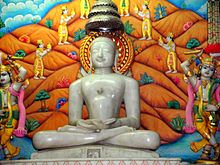Ajitanatha
| Ajitanatha | |
|---|---|
 Lord Ajitanatha (Mathura Chaurasi) | |
| Predecessor | Rishabhanatha |
| Successor | Sambhavanatha |
| Symbol | Elephant |
| Height | 450 bows (1,350 meters) |
| Age | 72 lakh purva (508.032 x 1018 years old) |
| Color | Golden |
| Genealogy | |
| Born | Maha Sud 8, 5 x 10223 years ago |
| Died | Chaitra Sud 5 |
| Parents |
|
| Dynasty | Ikshvaku |
| Part of a series on |
| Jainism |
|---|
 |
In Jainism, Ajitnatha was the second tirthankara of the present age, avsarpini (half time cycle).[1] The soul that became Ajitanatha, in its earlier incarnation, was the great King Vimalvahan of Susima city in Mahavideh area. He led a pious life in spite of the available princely grandeur. At an appropriate time, he became an ascetic under Arindam Suri. Ajitnatha was born to King Jitashatru and Queen Vijaya at Ayodhya in the Ikshvaku dynasty.[1] According to Jain beliefs, he became a siddha, a liberated soul which has destroyed all of its karma.
As a historical figure
The Yajurveda mentions the name of Ajitanatha, but the meaning is not clear. According to Jain traditions, his younger brother was Sagara. Sagara, who became the second Chakravartin, is known from the traditions of both Hindu and Jain scriptures.[2]
- From the Hindu source: Sagara is known to have had many sons. One of them was Bhagiratha, who brought the river Ganges.
- From the Jain source: In his last days, Sagara adopted the life of asceticism from Ajitanatha and retired from the worldly life.
Famous Temple
Taranga Jain Temple : It is around 900 years old.
Ajitnath Digambar Jain Atishaya Kshetra Bandhaji : It is around 1,500 years old.
Gallery
-
Tirthankara (possibly Ajitanatha), India, Southern Rajasthan, c. 12th century, marble
-
Ajitnath Tonk, Shikharji
-
Footprint at Ajitnath Tonk, Shikharji
See also
Notes
- ^ a b Tukol, T. K. (1980). Compendium of Jainism. Dharwad: University of Karnataka. p.31
- ^ http://www.fas.harvard.edu/~pluralsm/affiliates/jainism/article/antiquity.htm
References
- Tukol, T. K. (1980), Compendium of Jainism, Dharwad: University of Karnataka
- Shah, Umakant Premanand (1987), Jaina-Rupa Mandana: Jaina Iconography, vol. 1, India: Shakti Malik Abhinav Publications, ISBN 81-7017-208-X




